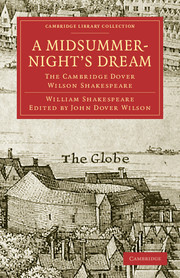THE STAGE-HISTORY
Published online by Cambridge University Press: 07 September 2010
Summary
Meres mentions A Midsummer-Night's Dream in Palladis Tamia (1598). The title-page of the quarto of 1600 says that it had been publicly acted by the Lord Chamberlain's servants. In 1624, a Protestant writer, John Gee, mentions in his book, New Shreds of the Old Snare, the comedy of ‘Piramus and Thisbe, where one comes in with a Lanthorne and Acts Mooneshine.’ In his Works, published in 1630, John Taylor, the water-poet, calls the play by its true name, and quotes the prologue to the clowns' tragedy (Address to Nobody, prefixed to Sir Gregory Nonsence his Newes from No Place). Evidently, the play, or some part of it, held the stage in the reigns of James I and Charles I; but the title given to it by Gee might suggest that already the popularity of the clowns had led to their being separated from the comedy, as they have been since in a hundred theatres, and in innumerable school speech-days. They were certainly so separated after the closing of the theatres in 1642. Their rehearsal and performance were turned, as Francis Kirkman records in The Wits, into one of the ‘humours and pieces of Plays, which… were only allowed us, and that but by stealth too, and under pretence of Rope-dancing, or the like.’ This ‘droll,’ called The Merry Conceited Humors of Bottom the Weaver, was published separately by Kirkman and Marsh in 1661, and included by Kirkman in The Wits in 1673.
- Type
- Chapter
- Information
- A Midsummer Night's DreamThe Cambridge Dover Wilson Shakespeare, pp. 160 - 168Publisher: Cambridge University PressPrint publication year: 2009First published in: 1924



